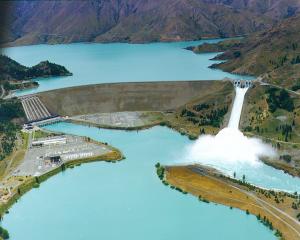Moeraki gets its main road back tomorrow after a massive community effort that is probably unique in New Zealand.
Since February, the community has raised $130,000, volunteers have spent about 3300 hours and a huge amount of material has been donated to rebuild about 400m of Haven St, closed for almost two years because of slippage.
No-one knows what that is worth, but estimates are it is more than $1 million.
The Waitaki District Council decided in August 2013 the road would stay closed because of the ongoing cost of trying to keep it open.
But pressure from the community to reopen it grew, culminating in an offer from the community last December to raise money and do the work itself.
It has been a mammoth task, steered by former roading engineer and project manager Bruce Wheeler and utilising the volunteers' skills and donations of machinery and materials.
''The last month has been a bit drawn out getting there,'' Mr Wheeler said yesterday as he watched his volunteer workforce making last-minute preparations for tomorrow's ceremony at 2pm, when Waitaki Mayor Gary Kircher will officially open what is basically a totally new section of road.
Yesterday, Mr Kircher said the community had done ''a brilliant job - far more than anyone, including those involved, probably ever expected''.
The project had been a ''moving feast'', growing as it went along.
''I'm blown away by the job they have done.''
The council had originally allocated $50,000 to the project, with the community matching that with $50,000.
The community had raised considerably more to go with the volunteer labour, donated machinery and materials and the council was expected to have contributed about $150,000 through extra work at the approaches and sealing in the future, Mr Kircher said.
At tomorrow's opening, Mr Wheeler will drive his classic Morris over the new road with the instigator of the project, Bill Pile, as passenger, leading volunteers and the community.
What they will see belies the actual work that has gone into the project - like an iceberg, most of it is below the surface.
When the volunteers started work, there was a single lane, buckled road with sharp drop-offs at each end, water-logged above and below which was contributing to the continued movement of the hillside.
Those problems have now gone, replaced by a two-lane shingle road - which it is hoped will be sealed once it has consolidated - and a rest area with a picnic table, providing a view of the coast up to Hampden.
To get to that stage has involved a lot of hard work by men and machinery, plus donated money and materials, fuelled by lunches, morning and afternoon teas provided virtually every day on site by a group of six local women, prompting one volunteer to say he had put on weight, despite the hard work.
Regular donations of fish and chips and ''a few beers'' from those who could not be there, such as holiday home owners, kept the workforce fuelled.
The former road has been lowered about 2.5m in the middle to cut back the load on the slippery clay. One end had to be gradually built up by 6m and the other by 12m where it had slumped away.
Drainage has been put through it to take stormwater from the surrounding area and drain the road's foundation. The bank below the road has been stepped at the bottom for support using old concrete power poles held in place by pipes in drill holes filled with cement.
A bank at the northern approach has been cut back and planted out.
But underneath is a key piece of engineering devised by a
volunteer who used his experience to find a solution on how to stop all that work slipping away again in the future.
Now retired in Moeraki, Laurence McGuire has worked for about 50 years on drilling rigs, including stabilisation in the Cromwell Gorge.
He came up with a way to stabilise the road for the future, believed to be the first time used in this area.
A drilling rig punched 57 holes into the ground on the sea side of the road face. Into each went a 20cm steel casing into which a 125mm pipe with railway iron welded into the centre was inserted.
Cement was poured in as the casing was withdrawn, spreading into the rock and shingle base to become concrete and form a grouting wall.
Mr McGuire believed the approach could be used on other sections of Haven St to stop slippage.
''I'm confident what we have done will last more than 50 years with no slippage,'' he said.
Moeraki Village Holiday Park co-owner Kristina Mitchell, whose husband Robbie and son Craig worked on the road, was ''absolutely terrified'' when she spoke at a public meeting for the first time in December, urging the council to reopen the road.
Yesterday, she praised the end result as ''a fantastic job'' with wonderful support from the majority of the community.
She believed the road closure had affected businesses in Moeraki, including the holiday park, which had lost a lot of business because people found it difficult to use the detour.''
I'm sure things will really pick up now,'' she said.











